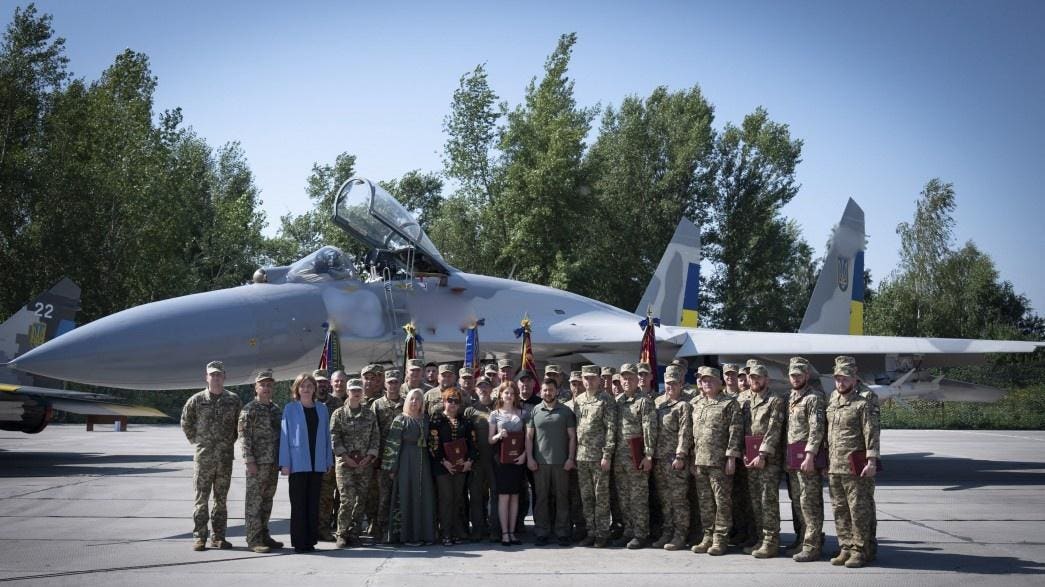The Ukrainian air force wasn’t supposed to last more than a few days in a wider war with Russian forces. Eighteen months later, the air arm not only has lasted—it has transformed into a long-range strike force. One that is shaping the battlefield across Ukraine.
And remarkably, the air force is growing more survivable as time goes on: firing new Western rockets and missiles over greater distances, and thus avoiding the most intensive Russian air-defenses.
On Feb. 25, 2022, the day Russia escalated its then eight-year war on Ukraine, Kyiv’s air arm had just 125 or so aging, ex-Soviet warplanes: around 50 Mikoyan MiG-29s, 30 Sukhoi Su-25s and a couple dozen each Sukhoi Su-27s and Sukhoi Su-24s.
Some observers expected Russian missile attacks and fighter sweeps entirely to eliminate Ukraine’s fighter and attack brigades within hours or days.
That didn’t happen. Tipped off by NATO intelligence that the attack was coming, Ukraine’s fighter and attack crews flew their planes to small airfields and roadway airstrips, dodging the initial barrages on their main bases. Flying into battle, the pilots stayed low—really low—to minimize their exposure to Russian missiles.
After a year and a half of hard fighting, the air force has lost no fewer than 69 aircraft—to ground-based air-defenses, mostly—but has managed to maintain its overall front-line strength by restoring old, grounded airframes and acquiring from NATO countries 18 Su-25s and 27 MiG-29s.
Equally importantly, the air force has armed each of its front-line types with new Western-made munitions with greater range than the Soviet munitions they replaced. Significantly greater range, in some cases.
The Su-25s got American-made Zuni rockets that distance and accuracy to their distinctive “rocket-tossing” attacks at targets as far as five miles away. The MiG-29s and Su-27s got, from U.S. stocks, High-Speed Anti-Radiation Missiles that home in on enemy radars from as far away as 80 miles.
Perhaps most notably, the air force has armed its Su-24s with two types of cruise missile, the British Storm Shadow and French SCALP, both of which can travel 155 miles. In just the past couple of weeks, Su-24s firing cruise missiles have blown up a Russian vehicle depot and dropped several vital bridges carrying supplies into Russian-occupied southern Ukraine.
The shift to stand-off attacks—all Ukrainian jets except the Su-25s can fire munitions from beyond the range of most of Russia’s ground-based air-defenses—greatly has boosted the life-expectancy of Ukrainian pilots. After writing off more than 60 jets last year, this year the air force apparently has lost just four MiG-29s, an Su-24, an Su-25 and an Su-27. A rate of loss for 2023 that’s a fifth what it was in 2022.
If the most recent phase of the Ukrainian air force’s transformation saw it adopt modern Western munitions, the next phase should see it adopt Western planes. After many months of diplomacy, the United Kingdom and The Netherlands back in May announced they would work together to train Ukrainian pilots to fly Lockheed Martin F-16s.
The Netherlands meanwhile signaled it would donate to Ukraine some of its roughly three dozen active and retired F-16s after the training is complete. A White House official said a training plan should be in place “towards the end of the year.”
The F-16 is not a new plane. The fighters The Netherlands might donate to Ukraine were built in the 1980s and deeply upgraded 20 years later.
But the F-16 fully is compatible with a wide array of modern munitions—and, for instance, can fire HARM anti-radar missiles in their most accurate mode.
The F-16 isn’t some wonder weapon. But it should help the Ukrainian air force to fire more and better missiles even farther and more accurately than it’s doing now. In the wider war’s third year, that could mean even fewer losses for an air force that wasn’t supposed to last more than a few days.
Read the full article here





